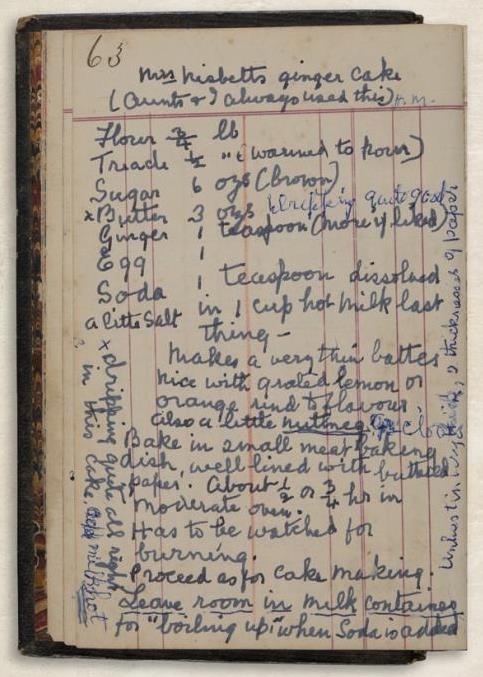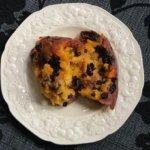The recipes in our archives and collections remind us just how much personality and good will is shared in culinary exchanges, and the importance of memory in recipes that have been passed on by friends and neighbours, and down through generations.
While many manuscript recipes in our collections are anonymous, several are attributed to particular people, some of whom we know very well and others who we know little, or even nothing about. Often named for specific people, the manuscript recipes from Meroogal are particularly rich with attributions: ‘Auntie Tot’s lemon biscuits’, ‘Aunt Kate’s shortbread’, and ‘Bob’s pudding’.
Mrs Nisbett’s ginger cake
‘Mrs Nisbett’s ginger cake’ is a definite favourite of mine, having a wonderfully dense texture – or ‘toothsome’ as might have been said in Mrs Nisbett’s day. Embellished with rum butter filling and pieces of crystalised ginger (pictured above) it is often featured on the menu at No.10 Bistro and Store at The Mint in Sydney’s Macquarie Street. The original recipe was recorded in a re-purposed ledger book by 3rd generation Meroogal resident, Helen Macgregor in the early 1900s, clearly recommended by her and her Thorburn aunts – Georgina, Belle, Kate and Tottie.

Mrs Nisbett’s ginger cake recipe, recorded by Helen Macgregor at Meroogal, Nowra. Meroogal collection. © Sydney Living Museums
Who’s who?
Tottie Thorburn makes mention of a Mrs Nisbett (and a Mrs Nesbitt, quite possibly the same person misspelled) in her diaries for 1892 and 1893, as they pay visits and socialised at each others homes. It is highly possible that she may be the original source of the recipe. But of course we wonder, who was she? With a little digging around historical records for Nowra at the turn of the twentieth century, the wonderful Trove digital newspapers resource came up trumps, – not from Nowra, but Molong, in central New South Wales. According to a 1902 article titled ‘An old Molongite’, a Mr Nisbett, the local police magistrate, and his family were leaving Nowra to take up a new post in Glen Innes, some 750 kms from Nowra, in north-eastern New South Wales. Nisbett met and married ‘Miss Durack (sister of Mrs W. P. Cahill, of the Royal Hotel)’ who, with some more digging, ‘the Curator’ has identified as a Kate Mary Durack. She married John Hyde Nisbett in 1879, and went on to have five children, the youngest born in Nowra in 1889.
Clearly they were active in the community and established close friendships, and ‘the final wrench of leaving was in a measure painful’ for them.
‘If anything further were needed to evidence the appreciation in which they were held by the community, it was furnished by the number of friends who mustered at the railway station to say goodbye.’
Mrs Nisbett’s friends gathered one afternoon to farewell her and her daughter:
The occasion was both a happy and a sad one … the parting of friends whose friendship dated back for fourteen years was inseparable from a tinge of sadness… [Her friends] presented her with a beautiful pearl pendant brooch and necklet to match, and her daughter with a gold necklet.
It’s highly likely that Tot and her sisters were among the well-wishers, and one wonders if a slice of ginger cake was enjoyed by all on that bitter-sweet afternoon.
Mrs Nisbett’s ginger cake
Ingredients
- 340g (2 cups, densely packed) plain flour
- 3 teaspoons ground ginger, or to taste
- 1/2 teaspoon ground nutmeg
- 85g butter, softened to room temperature
- 170g (1 cup, lightly packed) brown sugar
- 1 large egg (about 65 g)
- 225g treacle, warmed
- 2 teaspoons lemon zest (or orange zest) (optional)
- 250ml (1 cup) milk
- 1 teaspoon bicarbonate of soda
Note
Adapted from a manuscript recipe at Meroogal, this cake has a rich flavour and dense texture, akin to true gingerbread. For a more Victorian-style gingerbread, add a teaspoon of ground allspice.
Serves 8–10
Directions
| Preheat the oven to 180ºC (160ºC fan-forced). Position the oven rack one rung lower than the centre rung. Grease a 20-cm square cake tin and line with baking paper. | |
| Sift the flour into a bowl, add the ginger and nutmeg and a pinch of salt. Set aside. Beat the butter and the sugar until creamy and pale, then beat in the egg. Stir in the warm treacle and lemon zest, if using, with a wooden spoon. Add the flour mixture and fold it through. Bring the milk to the boil in a saucepan over low heat, then add the bicarbonate of soda. Add the milk to the cake batter while hot and foaming and stir to make a smooth batter. | |
| Transfer the batter to the prepared cake tin and bake for 1 hour or until a skewer inserted into the centre of the cake comes out clean. Make sure the top of the cake doesn't burn. If it is browning too quickly, cover it with two sheets of baking paper. | |
| Rest the cake in the tin for 15 minutes before turning it out onto a wire rack to cool. | |

 Print recipe
Print recipe
